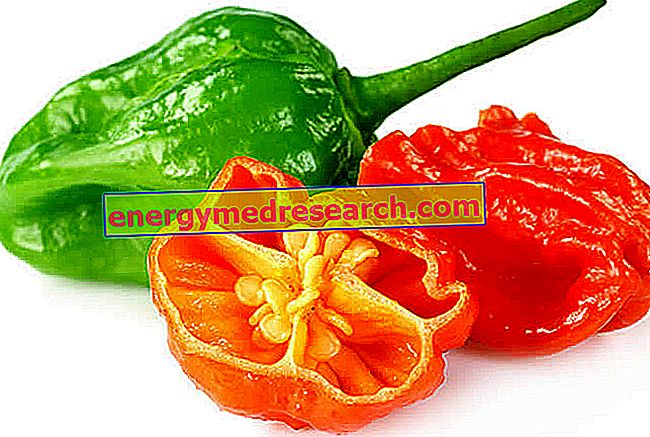Generality
The Naga Morich is one of the hottest varieties of chili in the world.
The fruits obtained from this plant are classified as "exceptionally spicy" and, on the Scoville scale, reach a score of 1, 000, 000 SHU. To have a yardstick, consider that the Habanero pepper (best known in Italy) is rated as "extremely spicy" but, in the Scoville ranking, reaches levels of 80, 000-577, 000 SHU.

Botanically, the Naga Morich plant should be a hybrid between two Species. It is part of the Solanaceae Family, Genus Capsicum, Specie chinense x frutescens (binomial nomenclature Capsicum chinense x frutescense ).
It is very similar to Bhut Jolokia, commonly called "Ghost Pepper", but it is grown in Bangladesh and in the North East of India (Bhut Jolokia instead is typically Mexican / American).
In the United Kingdom, the Naga Morich is also known as Dorset Naga (original name of Bangladesh).

Nutritional Features
The fruit of the Naga Morich is a food of vegetable origin that belongs to the VI and VII group of foods.
It has a very low energy intake, to which carbohydrates contribute above all; lipid and protein concentrations are marginal.
The Naga Morich is a food that, when eaten raw, is an excellent source of vitamin C (ascorbic acid). Furthermore, it contains excellent concentrations of caroteonoids (beta-carotene, lycopene and other provitamins A). All of these vitamins and provitamins perform many essential functions for the body and work together to neutralize free radicals. This antioxidant function is also supported by NON-essential elements and different from vitamins: flavonoids, phenolic acids, chlorophyll derivatives, etc.
Vitamin A is a fat-soluble type and its absorption is facilitated by the presence of fatty acids in the intestinal lumen. In theory, the bile juices are able to dilute and emulsify any meal, allowing digestion and absorption. However, especially in subjects who have had their gallbladder removed (cystellectomy), the intestinal absorption of vitamin A can be promoted with the addition of a tablespoon of extra virgin olive oil.
It should also be borne in mind that vitamin C is a thermolabile type; this means that it can be severely damaged by cooking. For this reason, it is recommended that the Naga Morich be eaten raw.
However, further nutritional consideration is a must. While sacrificing the vitamin C content, cooking is very useful in the partial hydrolysis of the skin, therefore in the increase in overall digestibility. NB . The heat treatment also allows peppers to be peeled (grilling, boiling and frying).
The Naga Morich also contains a lot of water, dietary fiber and potassium.
Chillies are foods that do not lend themselves to all diets. They have all the advantages of any vegetable but, due to the massive presence of capsaicin, their use in the diet is precluded in case of: gastritis, ulcer (gastric and duodenal), gastroesophageal reflux, irritable colon, anal fissures, haemorrhoidal disease, etc. . It is also to be avoided for pregnant women and nurses.
For subjects that are normally sensitive to spiciness, the medium portion of this chili pepper strongly limits its nutritional meaning.
According to nutritional values, the average portion of Naga Morich could in fact easily reach 300g, but (in Italy) few people can tolerate even 5g of this food.
Culinary uses
The Naga Morich is extremely spicy, but it is known above all due to its characteristic flavor.
Some connoisseurs claim that its capsaicin content (spicy molecule) is similar to that of Bhut Jolokia (Ghost Pepper); others consider it inferior and place it in third place on the world scale.
The Naga Morich has a sweet and slightly acid taste, followed by woody and smoky notes.
In Bengali cuisine, this red pepper is traditionally still used green and raw, as a side dish.
It is particularly suitable for accompanying barbecue meals, both raw and grilled.
To reduce the concentration of capsaicin it is necessary to deprive it of the seeds and the placenta, or the whitish and internal film of the fruit to which the seeds are attached.
 | ||
| Chemical composition | Value for 100g | |
| Edible part | 89.0% | |
| water | 87, 8g | |
| Protein | 1.8g | |
| Limiting Amino Acid | - | |
| Total lipids | 0.5g | |
| Saturated fatty acids | - g | |
| Monounsaturated fatty acids | - g | |
| Polyunsaturated fatty acids | - g | |
| Cholesterol | 0, 0mg | |
| Carbohydrates available | 3, 8g | |
| Starch | 2, 1g | |
| Soluble sugars | 1.5g | |
| Total fiber | - g | |
| Soluble fiber | - g | |
| Insoluble fiber | - g | |
| Phytic acid | - g | |
| Alcohol | 0.0g | |
| Power | 26, 0kcal | |
| Sodium | 7, 0mg | |
| Potassium | 230, 0mg | |
| Iron | 0.5mg | |
| Football | 18, 0mg | |
| Phosphorus | 18, 0mg | |
| Magnesium | - mg | |
| Zinc | - mg | |
| Copper | - mg | |
| Selenium | - µg | |
| Thiamine | 0, 09mg | |
| Riboflavin | 0, 23mg | |
| Niacin | 3, 0mg | |
| Vitamin A retinol eq. | 824, 0μg | |
| C vitamin | 229.0 | |
| Vitamin E | - mg | |
Botanical characteristics
Like many varieties of the Chinense species, the Naga Morich is a small or medium-sized shrub. It has large leaves and small flowers with five petals, from which spicy fruits are born.

Distribution
The plants are native to North East India and Bangladesh.
Today they are also produced in the United States, the United Kingdom (Dorset Naga) and Australia, where their cultivation finds use in the production of spicy sauces.
In Finland it is sold mostly fresh, in small and large retailers. It is also present in West Africa. In Italy its expansion took place with a slight delay.



